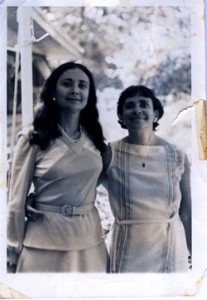Hadassah
Feature
Candles in the Window: Where Memory Never Runs Out

Flames in thick, squat glass tumblers flickered on the kitchen counter of my Brooklyn home as my mother, the designated keeper of our extended family’s memory, observed yortzeit after yortzeit, commemorating the deaths of a multitude of relatives
“Yortzeits are important, not only because they mark the day of a death but because they recall the life of the deceased,” she explained, as she held a match to the wick.
The candle she lit with such tenderness burned for a full 24 hours in adherence to Proverb 20:27: “The soul of man is the lamp of the Lord.”
The next day, the glass was scoured and used for juice, milk and even for the sip of shnapps that my father occasionally allowed himself. It seemed fitting that the sturdy tumbler, which had contained a memorial candle, so effortlessly became part of the daily life of our household. Continuity was assured, grief and memory assimilated, life and death melded.
Given the frenetic pace of contemporary life and a shift in priorities, there are few memory keepers like my mother. When Esther, my beloved younger sister, died suddenly, I worried that her yortzeit would not be observed in perpetuity. I remembered Hadassah’s unique and compassionate program guaranteeing that the yortzeit of a departed loved one would never be forgotten. My sister’s name and the Hebrew date of her death, Tevet 13, would be inscribed in beautiful calligraphy in a bound book that is in the Abbell Synagogue of the Hadassah–Hebrew University Medical Center at Ein Kerem, Jerusalem, and on the anniversary of her death, a rabbi would recite Kaddish for her and a portion of the Mishna would be studied to honor her memory. Each year I would receive notice that this mitzva would be kept.
Esther had been a dedicated Hadassah member, the chair of the Westchester County Youth Commission and a frequent visitor to Israel and to the hospital to which we had dedicated so much time and effort. She was also a Hebraist and a lover of talmudic texts.
Without hesitation, then, I arranged to have her name recorded in Ein Kerem.
On the 12th anniversary of her death, quite serendipitously, I was in Jerusalem. The city was in the grip of a melancholy winter, but when I reached the Abbell Synagogue, it was aglow with the luminous Chagall windows.The ironic ambience of that modest room dedicated to prayer and study was a marked contrast to the busyness of the rest of the hospital, where the race to save lives continues unabated day and night. Prayerbooks and Bibles were neatly stacked in the serried wooden pews. Two young doctors, their stethoscopes dangling, stood beside two soldiers. Their murmured prayers drifted through the soothing silence. I waited as an elderly couple pored over the memory book with the name of their loved one, passing their fingers across the page, whispering the Kaddish.
When they left, the woman supported by her husband, I approached the simple wooden cabinet that contains the separate volumes of names. I selected the tome of Tevet and placed it on the lectern, resting it between two brass candlesticks, so like the ones used by my grandmother.
I touched my sister’s name and murmured softly, Esther Malka bat David Ha-Cohen, and recited the Kaddish, that magnificent prayer of acceptance. A simple text, two profound words, is carved above the lectern: L’Netzach B’Yisrael (Forever in Israel). How comforting those words were for me as I stood in that quiet synagogue on that wintry day. I knew then that my sister’s name, her life and her love of Zion would live on forever, in this city on the hill from which all solace comes.
My mother’s legacy endures. The pedagogy of her simple action as she lit those fragile flames is not forgotten. Yortzeit, as she taught, is both an observance of the anniversary of a death and an affirmation that the life of the departed will not be forgotten. “Forever in Israel.” “Forever in memory.”
For information on Hadassah’s “Yahrtzeit” in perpetuity program, go to www.hadassah.org.









 Facebook
Facebook Instagram
Instagram Twitter
Twitter
Leave a Reply